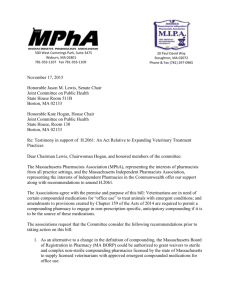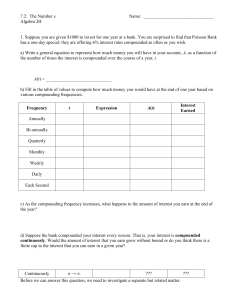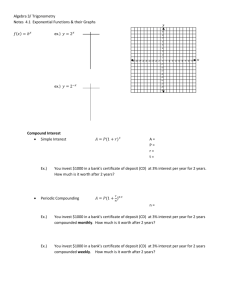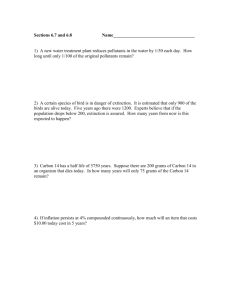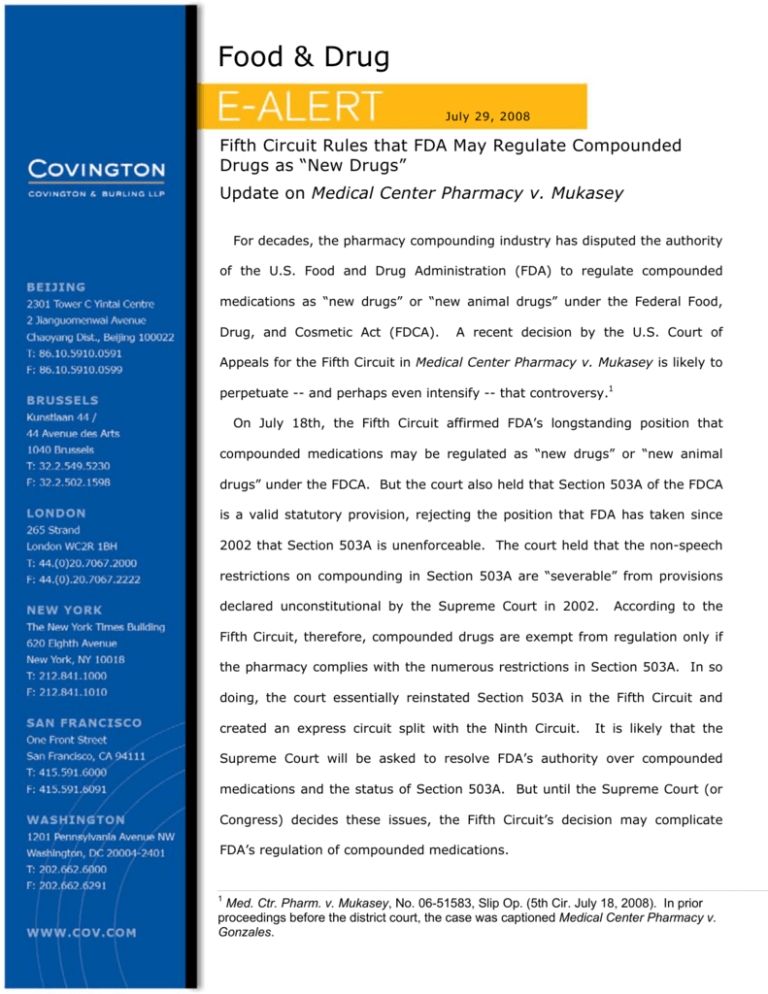
Food & Drug
July 29, 2008
Fifth Circuit Rules that FDA May Regulate Compounded
Drugs as “New Drugs”
Update on Medical Center Pharmacy v. Mukasey
For decades, the pharmacy compounding industry has disputed the authority
of the U.S. Food and Drug Administration (FDA) to regulate compounded
medications as “new drugs” or “new animal drugs” under the Federal Food,
Drug, and Cosmetic Act (FDCA).
A recent decision by the U.S. Court of
Appeals for the Fifth Circuit in Medical Center Pharmacy v. Mukasey is likely to
perpetuate -- and perhaps even intensify -- that controversy.1
On July 18th, the Fifth Circuit affirmed FDA’s longstanding position that
compounded medications may be regulated as “new drugs” or “new animal
drugs” under the FDCA. But the court also held that Section 503A of the FDCA
is a valid statutory provision, rejecting the position that FDA has taken since
2002 that Section 503A is unenforceable. The court held that the non-speech
restrictions on compounding in Section 503A are “severable” from provisions
declared unconstitutional by the Supreme Court in 2002.
According to the
Fifth Circuit, therefore, compounded drugs are exempt from regulation only if
the pharmacy complies with the numerous restrictions in Section 503A. In so
doing, the court essentially reinstated Section 503A in the Fifth Circuit and
created an express circuit split with the Ninth Circuit.
It is likely that the
Supreme Court will be asked to resolve FDA’s authority over compounded
medications and the status of Section 503A. But until the Supreme Court (or
Congress) decides these issues, the Fifth Circuit’s decision may complicate
FDA’s regulation of compounded medications.
1
Med. Ctr. Pharm. v. Mukasey, No. 06-51583, Slip Op. (5th Cir. July 18, 2008). In prior
proceedings before the district court, the case was captioned Medical Center Pharmacy v.
Gonzales.
I.
Background
Compounding refers to the practice of a pharmacy customizing a specific drug to meet
the unique medical needs of a specific patient; for example, preparing a medication for a
patient that is allergic to an ingredient found in the commercial version of an FDAapproved drug.
Compounding had traditionally been regulated by state boards of
pharmacy. However, in the early 1990s, FDA became concerned that some compounding
pharmacies were mass-producing and marketing drugs under the guise of pharmacy
compounding.
In order to curtail this end-run around FDA’s regulation of drug
manufacturing, the agency issued a Compliance Policy Guide (CPG), which took the
position that compounded drugs were subject to the “new drug” provisions of the FDCA,
but that the agency would generally exercise enforcement discretion over traditional drug
compounding.
However, if the activities of a pharmacy were more akin to large-scale
manufacturing, FDA would not exercise enforcement discretion and could take regulatory
action. FDA’s 1992 CPG listed nine non-exhaustive factors that the agency would take into
consideration when evaluating whether to exercise enforcement discretion.
Several years later, as part of the Food and Drug Administration Modernization Act of
1997 (FDAMA), Congress enacted Section 503A of the FDCA. Pub. L. No. 105-115, 111
Stat. 2296, codified at 21 U.S.C. § 353a. Section 503A expressly exempted compounded
medications for human use from three provisions of the FDCA, including the new drug
approval, adulteration, and misbranding provisions. 21 U.S.C. § 353a(a). Compounding
pharmacies, however, could take advantage of this exemption only if they complied with
other restrictions in 503A.
For example, Section 503A requires that compounding
pharmacies use bulk ingredients that comply with a USP monograph, are components of
FDA-approved drugs, or appear on a list developed by FDA. Id. at 353a(b). Section 503A
restricts pharmacies from producing copies of commercially available drugs and requires
compounding to be pursuant to a valid prescription. Id. at 353a(a), (b).
Section 503A also contained restrictions on the ability of pharmacies to solicit
prescriptions or to advertise specific compounded medications. Id. at 353a(a), (c). The
2
speech restrictions in section 503A were challenged by a group of pharmacies in the
Western States litigation.
In that case, the Ninth Circuit held that the restrictions on
speech violated the pharmacies’ First Amendment rights and were thus unconstitutional.
W. States Med. Ctr. v. Shalala, 238 F.3d 1090 (9th Cir. 2001). The Ninth Circuit also held
that the unconstitutional provisions could not be severed from the rest of Section 503A
and, as a result, all of Section 503A was invalid and unenforceable. Id. at 1096-98. When
the case was appealed to the Supreme Court, neither party challenged the Ninth Circuit’s
ruling on severability. Thompson v. W. States Med. Ctr., 535 U.S. 357, 360 (2002). The
Supreme Court agreed with the Ninth Circuit that 503A’s speech restrictions were invalid,
but did not rule on whether those provisions could be severed from the rest of 503A. Id.
at 368-77.
After the Supreme Court’s decision, FDA took the position that it would follow the Ninth
Circuit’s severability ruling and, as a result, it has treated all of Section 503A as invalid.
The agency issued a new CPG for human drugs in 2002 (FDA CPG 460.200) and a similar
CPG for compounded animal drugs in 2003 (FDA CPG 608.400).
Both CPGs set forth
factors that the agency would take into account in exercising enforcement discretion over
compounding activities.
Since that time, FDA has inspected numerous compounding
pharmacies, issued warning letters, and taken other regulatory action pursuant to its
CPGs. See http://www.fda.gov/cder/pharmcomp/default.htm.
But controversy over FDA’s regulatory authority persisted.
In 2004, a group of
pharmacies brought the Medical Center Pharmacy litigation, challenging the agency’s
authority to regulate compounded drugs and to inspect state-licensed retail pharmacies.
Med. Ctr. Pharmacy v. Gonzales, 451 F. Supp. 2d 854 (W.D. Tex. 2006). Among other
requests for relief, the pharmacies sought declarations that compounded drugs are not
“new drugs” or “new animal drugs” under the FDCA.
The pharmacies also requested a
declaration stating that FDA does not have the authority to declare compounding of drugs
from bulk ingredients for non-food-producing animals to be illegal, or to enforce the CPGs
applicable to either human or animal drug products.
3
In 2006, a federal district court granted many of the pharmacies’ requests for relief.
The court held that compounded medications were “implicitly exempt” from the new drug
and new animal drug provisions of the FDCA. The court also addressed (sua sponte) the
validity of Section 503A, stating that the unconstitutional speech restrictions may be
“severed and the remainder of the statute remains in full effect.” Id. at 863. The district
court also held that compounding from bulk ingredients for non-food-producing animals is
not prohibited by the FDCA. The case was appealed to the Fifth Circuit.2
II.
Decision of the Fifth Circuit
The Fifth Circuit’s opinion began by considering and rejecting the district court’s
determination that compounded drugs are “implicitly exempt” from the “new drug”
provisions of the FDCA. The court applied a straightforward textual analysis, stating that:
Under the plain language of [the new drug definition in section]
321(p)(1), it does not matter that the substance has been created
through compounding rather than manufacturing--whether it be through
rigorous research and development by a pharmaceutical company,
through individualized compounding by a pharmacist or through cut-rate
production by a rouge manufacturer. Regardless of how and by whom it
was created, “any” such substance constitutes a “new drug” within the
meaning of [the new drug] definition in 321(p)(1).
Slip Op. at 17. The court then went on to reject the pharmacies’ claims that the legislative
history of the FDCA and congressional intent should overcome the plain language of the
new drug definition.
The Fifth Circuit next turned its attention to Section 503A. Although both parties initially
argued that the court need not address severability, in supplemental briefing FDA argued
against severability and the pharmacies argued in favor of it. Id. at 28. The court noted
that Congress included an express severability clause in the FDCA: Section 901 of the
FDCA provides that if any section of the Act is declared unconstitutional “the remainder …
shall not be affected thereby.” 21 U.S.C. § 391. In light of this severability clause, the
court applied a presumption in favor of severability in order to preserve as much of the
statute as possible.
2
The court also recognized that Section 503A contained many
The district court also held that FDA’s inspection authority under section 704 of the FDCA does not
extend to the third sentence of section 704, commonly referred to as “records inspection” authority. The
district court rejected several claims brought by the plaintiffs under the Administrative Procedure Act.
Neither party appealed these aspects of the district court’s holding.
4
restrictions on the practice of compounding other than the constitutionally infirm speech
provisions.
“Severing the advertising requirement would leave those other considerable
requirements intact, and they would continue to effect Congress’s purpose.” Slip Op. at
31-32. Finally, the court considered and rejected the legislative history arguments relied
upon by the Ninth Circuit, concluding that it is “unfounded, on the basis of this legislative
history alone, to elevate the advertising provision over the others and treat it as a
necessary provision without which the bill would not have passed.”
Id. at 33-34.
The
court held, therefore, that the speech provisions of Section 503A should be severed from
the remainder of the law and, as a result, the remaining requirements of 503A are valid
and enforceable statutory provisions. Compounded medications may be exempt from the
new drug requirements of the FDCA (as well as adulteration and misbranding), only if they
meet all the other non-speech restrictions listed in Section 503A.
Finally, the Fifth Circuit addressed compounded drugs for animal use. Similar to human
drugs, the court agreed with FDA that the text of the FDCA, which broadly applies to “any
drug intended for use for animals other than man … the composition of which” has not
been approved by the FDA includes compounded medications.
21 U.S.C. § 321(v)(1).
The court noted that the Animal Medicinal Drug Use Clarification Act of 1994 (AMDUCA)
exempted new animal drugs from the FDCA’s drug approval process in certain
circumstances. Thus the court concluded that compounded drugs are “new animal drugs”
within the meaning of the FDCA, “[a]nd unless the compounded drugs are exempt under
the FDCA’s AMDUCA provisions, … compounded animal drugs are subject to the FDCA’s
unsafe, adulteration, and misbranding requirements.” Slip Op. at 41.
III.
Potential Implications
While certain parts of the Fifth Circuit’s holding clarify FDA’s regulation of compounded
drugs, other aspects of the decision may further complicate matters. On one hand, the
decision clarifies that compounded medications are subject to regulation in the Fifth Circuit
under the “new drug” and “new animal drug” provisions of the FDCA. This holding affirms
FDA’s longstanding position and rejects the holding of the lower court that compounded
5
medications are “implicitly exempt” from the FDCA. The holding is also a setback to the
compounding industry, which has long claimed that compounding activities are not subject
to FDA’s regulatory authority.
On the other hand, the court’s decision regarding Section 503A potentially complicates
FDA’s regulation of compounded medications. The holding is in direct conflict with that of
the Ninth Circuit in Western States. If this aspect of the decision is not reconsidered or
otherwise stayed, FDA will be required to apply Section 503A in the Fifth Circuit, while
continuing to apply its CPG in the Ninth Circuit and, presumably, the rest of the country.
But to apply Section 503A, the agency, however much it continues to distrust extensive
compounding as an evasion of section 505, would first have to engage in significant and
resource-intensive regulatory actions required by the statute, including rulemaking,
negotiating memoranda of understanding with state authorities, and other activities.
For these reasons, unless Congress intervenes with clarifying legislation, it is likely that
the Supreme Court will be asked to definitively resolve FDA’s authority over compounded
medications and the status of Section 503A.
If you have any questions concerning the material discussed in this client alert, please
contact the following members of our food & drug practice group:
Eugene Lambert
Jeannie Perron
Scott Danzis
202.662.5422
202.662.5687
202.662.5209
elambert@cov.com
jperron@cov.com
sdanzis@cov.com
This information is not intended as legal advice, which may often turn on specific facts. Readers should seek specific
legal advice before acting with regard to the subjects mentioned herein.
Covington & Burling LLP is one of the world’s preeminent law firms known for handling sensitive and important client
matters. This alert is intended to bring breaking developments to our clients and other interested colleagues in areas of
interest to them. Please send an email to unsubscribe@cov.com if you do not wish to receive future alerts.
© 2008 Covington & Burling LLP. All rights reserved.
6


